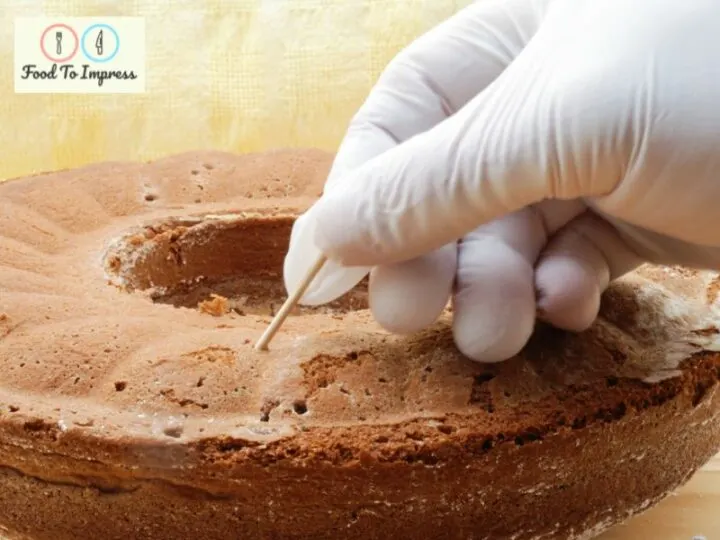Taking your cake out of the oven to find that it isn’t fully cooked is a pain, but it doesn’t mean that you have to worry about it. While it’s not ideal, you can still get a pretty decent cake out of it if you take the right steps. Read more to learn how to fix undercooked cake.
If you’ve cut into your cake after it’s been out of the oven for a while to find that it’s undercooked cake, you can’t do anything about it, unfortunately. You have to figure out what you’ve done wrong and try again. But don’t despair, you can learn how to create a perfectly cooked cake for the next time.
When your cake isn’t cooking in the middle, it’s often because the oven was too hot or it wasn’t baked for long enough. Every oven is different, so you can’t always rely on the recipe’s timing and temperature. Put the cake back in to bake for longer and cover it with foil if it’s browning too fast.
The best thing you can do is trust your oven to bake it through. This might take 5 minutes longer or 30 minutes longer. No matter how long it takes, a cake that’s slightly overcooked is better than an underbaked cake, so leave it to bake and test its doneness every 5-15 minutes until it’s fully baked.
On a side note, if you’re struggling with cakes that aren’t rising properly, it will be worth taking a few minutes to read an article I’ve written about the common problems that cause cakes to not rise and how to fix them. You’ll be able to figure out what went wrong and fix it in no time. Hint: check your baking powder.
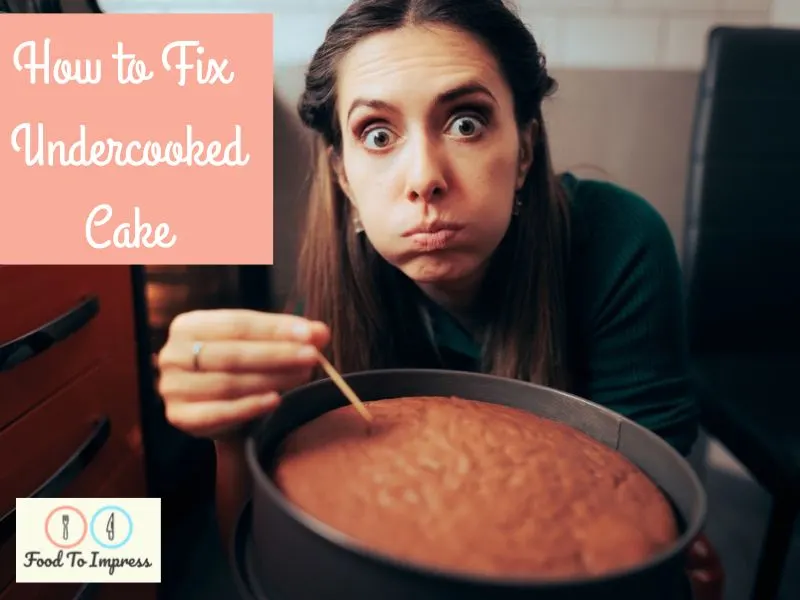
Causes Of An Undercooked Cake Center
Underbaking a cake is one of the most common mistakes in the cake-making community. It takes a lot of trial and error to figure out how to bake a cake properly, so you’re almost going to undercook it at some point.
Although it’s very annoying, it’s also likely to happen more than once if you’re not careful. To prevent it from happening, you need to understand what could be causing underbaked cake so you can avoid the mistakes.
Here’s what you should keep an eye out for. At least one of these reasons is most probably preventing baking cakes all the way through.
The Cake Tin Is Filled Too Deep
If you pour too much batter into your cake pan, it will be very thick and have a hard time baking evenly.
Whether you’re pouring too much cake batter into a small tin or you’re just overloading it, the result may not be a properly cooked cake.
When the cake tin is filled too deep, it’s very common for the exterior to be fully cooked while the interior is still raw cake batter. By the time the interior is fully baked-through, the exterior will be overcooked or may even be burnt.
Many people make the mistake of using the wrong pan size, even if they follow the ingredient recipe correctly. If you don’t have the right sized cake tins, go out and buy some. They don’t have to be expensive, and they can help to improve how your cakes turn out.
The Oven Temperature Isn’t Right
Your oven temperature is either too hot or not hot enough. This can result in insufficient baking time. On the one hand, you can have a burnt exterior before the center of the cake is cooked, or you can have a cake that takes a very long time to bake and dries out.
This might be because you’ve misread the recipe or you’re using a different kind of oven. For example, convection (fan) and conventional (regular non-fan) ovens technically run at different temperatures. Convection (fan) ovens need to be set to a lower heat than conventional as they run hotter and therefore bake faster.
Convection ovens should be lowered by 25°F (or 20°C) in order to have the same results.
Another thing to know is that oven thermostats can sometimes become inaccurate over time, meaning that the oven might be hotter or colder than what you set it to. You may need an oven thermometer to check on this issue.
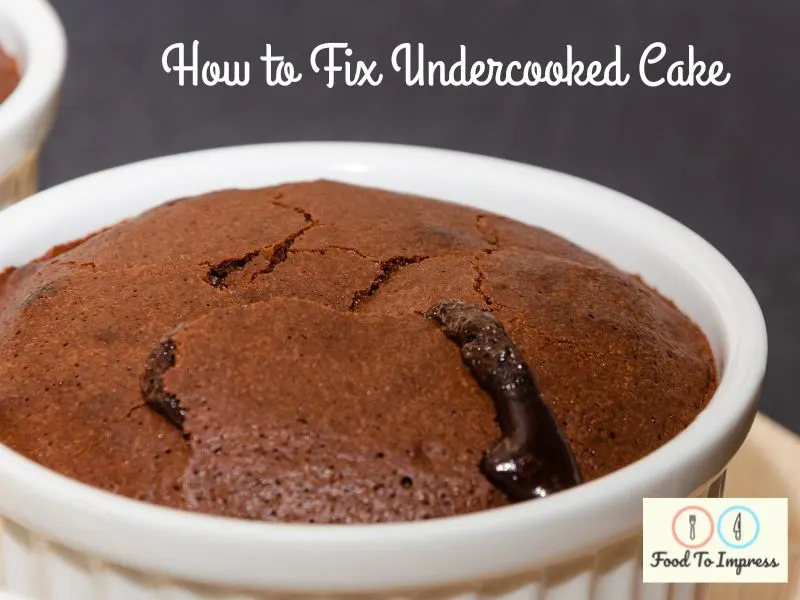
It’s Been Taken Out Prematurely
Almost everyone is eager to take their cake out of their oven right away, but this is something that will leave you with an underbaked center if you’re too eager.
You should wait until you know that the cake is fully cooked before taking it out of the oven. Instead of going purely by the baking time of the recipe, poke a thin skewer into the center of the cake. If it comes out clear, it should be fully baked, but if it comes slightly wet you’ll need to put it back into the oven. A wet toothpick or skewer indicates that the cake is undercooked. Increase the cooking time in 5 minute intervals and continue to check the cake.
By checking every five minutes or less you will avoid overcooking the cake.
Going by the timing in the recipe might sound like a good idea to some, but the timing can’t apply to everyone. The chances are that your environment, cake batter, and oven are all slightly different from what the original recipe used, so these variables will affect the cooking process.
Your Oven Heats Unevenly
Many home bakers’ ovens don’t produce heat evenly. Most have hot and cold spots, which can cause problems when baking or cooking anything. The top part of your oven make have more upper heat, a low temperature can be at the bottom of the oven or there can be hot spots in the middle part.
The poor heat of these ovens can cause food to cook unevenly, so throwing a large cake into your oven might not be cooking properly.
By the time one side of the cake is fully baked, the other side might still be like batter. If you know that the heat of your oven is uneven, you should rotate your cake 1-2 times during the baking process to help even out the heat.
Can You Still Eat Undercooked Cake?
While eating your undercooked cake might be tempting since you’ve put so much work into it, it’s not a good idea to do so. Since the center will still technically be raw cake batter, there’s a risk that you’ll get a nasty case of food poisoning if you do choose to eat it. Raw eggs can make you sick.
I know most people do have a lick or two of the cake batter from the spoon or bowl, but it can leave you regretting it soon after. Just one mouthful of your undercooked cake can make you ill, so you’re better off not risking it and baking another cake instead.
If you really don’t want to waste the cake, you can still cut into the cake and remove the undercooked part so you can eat the rest. If you do this, be careful to remove any part that seems undercooked.
How To Fix Undercooked Cake
If you’ve noticed that your cake is still undercooked even after it’s had the given time in the oven, there is only one appropriate way to ‘fix’ it.
Bake it for longer. As obvious as that sounds, many beginners still don’t bake their cake long enough and it remains undercooked.
There are some things to keep in mind if you need to bake your cake for longer. The biggest problem you might face when baking it for longer is overbrowning or burning. You need to be careful not to burn the cake before the center is cooked, so here’s what you might want to do:
Cover It With Foil And Bake For Longer
Once you notice that it’s not fully cooked, it needs to go back in the oven right away until it’s finished cooking. If it’s only slightly undercooked, check it every 5 minutes and take it out as soon as you can tell that it’s done. If it’s still very wet, check it every 10-15 minutes.
If the cake is already browned enough on the top or is browning too much, you need to put a protective barrier in between the cake and the direct heat in order to prevent further browning and burning.
By simply putting a layer or two of aluminum foil over the top of the cake tin, you’re going to slow the rate of the browning significantly since it won’t be getting the intense direct heat.
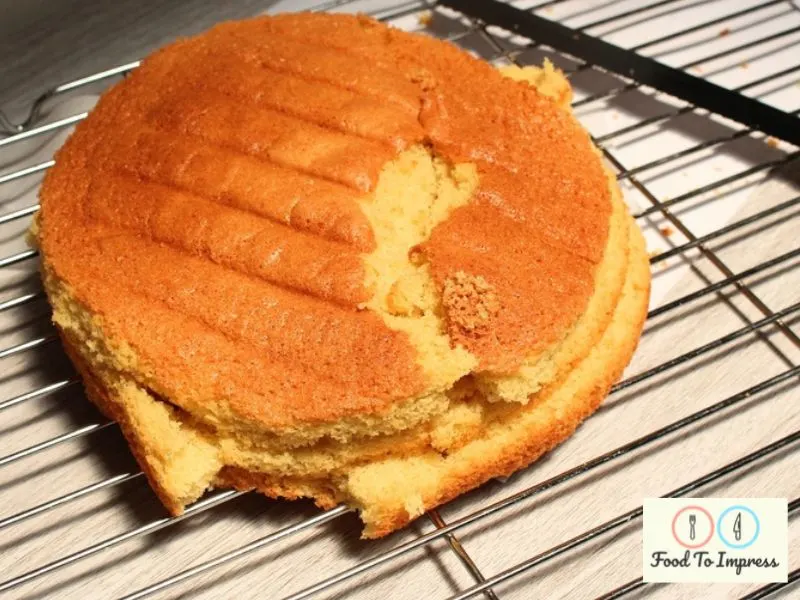
Learn How to Fix Undercooked Cake Before It Happens Again
You should learn from all the mistakes you make, so when you undercook your cake, you can get a better understanding of what to do next time in order to get a perfectly cooked cake.
There are some basic mistakes that you might need to put right when baking your next cake, so here’s a list of them to think about:
Set It To The Right Temperature
Setting your oven to the right temperature is vital in making sure that the cake bakes through properly. Too high a heat and the cake will be overcooked. Too low and the cake will take too long to cook, which will likely cause it to dry out due to it not baking very well.
Finding the right temperature for the specific cake you’re making doesn’t have to be difficult. If you found that your cake took too long to cook, increase the temperature. If the exterior was fully baked or overbaked before the interior, lower the temperature.
Everyone’s oven works differently, so it’s just a case of trial and error to find the perfect temperature for yours.
Check That Your Oven’s Temperature Is Correct
Although you might think your oven is at a certain temperature, it might not be. Over time, some oven thermostats can become inaccurate, meaning that this problem causes your oven to reach a temperature that’s different to what you set it to.
This can mean that the oven is either hotter or cooler than what you expect, which can ruin the baking time of your cake. If your oven’s thermostat is faulty, it can cause you to believe that you’re doing something wrong, when it is in fact that your oven isn’t at the correct temperature.
A cheap and easy way to find out if your oven is heating to the right temperature is to simply buy an oven-safe thermometer and keep it in there at all times. Check the thermometer’s temperature reading against the oven’s temperature dial and see if they match up.
If you see that your oven is heating to the wrong temperature, you’ll have to recalibrate it. Some ovens are supposedly easy to recalibrate, but some will need a service technician in order to solve the issue.
Use The Right Sized Cake Tin
If the recipe you’re using calls for a specifically sized cake tin, make sure to use that. Using a different sized cake tin will throw off the baking time, so you won’t be able to follow the recipe timing.
Unless you’re an experienced baker and know a lot about the baking times of cakes, you’ll just be playing a guessing game. Something too wide/big will most likely shorten the baking time whilst something too narrow/small will extend the baking time.
Preheat Your Oven For Enough Time
Since ovens often heat unevenly, you’re left with hot and cold spots to work with. These can cause uneven baking, which is exactly what you want to avoid if your cakes aren’t cooking in the middle.
To even out the oven’s temperature as much as possible, you should be preheating it for a long time before putting your cake in.
The longer it preheats, the more time it has to get every part of the oven to temperature, so you don’t have to worry as much about your cake baking unevenly. Set your oven to temperature 30-60 minutes before you put the cake in to bake and it will bake more evenly.
All ovens are still different of course, so your cake may not bake evenly after a long time preheating. Either way, it’ll still bake better after the oven has had a chance to heat through properly. Give it a go and see how well your cake bakes after this.
How To Know When Your Cake Is Fully Cooked
Knowing when your cake is fully cooked takes lots of practice and experience with plenty of different cakes, but that doesn’t mean that it’s impossible to tell when it’s done as a beginner.
Here are some of the methods you can do to test if your cake is fully bake:
Use A Toothpick
Using a toothpick, skewer, or kitchen knife to test the doneness of the cake is one of the most common methods used among home bakers.
The idea is that you push the toothpick into the center of the cake to check if the crumb sticks to it or not. If any of the cake’s crumb or batter sticks to it, it isn’t done and needs to be baked for longer. If nothing sticks to it, the cake should be completely baked (or at least very close).
This works by testing how much the cake’s crumb has set.
You want a crumb that’s completely set for the cake to be fully baked. Anything that sticks to your toothpick indicates that it isn’t set and therefore hasn’t fully baked.
Check If The Cake Has Pulled Away From The Sides
Assuming that you grease the cake tin’s sides before baking, you should notice that the cake pulls away from them as it bakes. This happens because as the crumb sets, it tightens and causes the cake to have a slightly smaller diameter than before baking.
Since the sides and top of the cake are what bake first, these are only the first signs of the cake baking properly, so it doesn’t always indicate that the center is baked through too. Although this can’t guarantee that the whole cake is fully baked, it gives you a good idea that the exterior of the cake has finished baking, so the interior should be almost finished too. This test is best used in combination with the other tests.
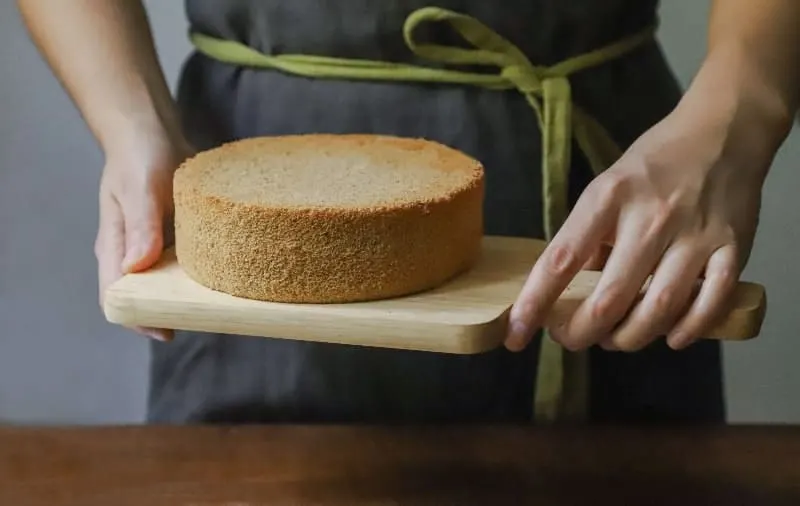
Check That It Bounces Back When Pressed
You’re looking to get a solid crumb for a fully baked cake, and you can test this by gently pressing your fingers into the surface of the cake. If you press into the cake and the indentation springs back, it’s a sign that the crumb structure is good and completely baked.
If you press into it and the indentation stays, the cake isn’t baked through and you should leave it in for longer, making sure to check every 5 to 10 minutes.
Frequently Asked Questions about How To Fix Undercooked Cake
Can you Rebake a cake if it’s undercooked?
Yes, you can rebake an undercooked cake. Allow it to cool completely before placing it back in a preheated oven at the original baking temperature for about 10-15 minutes or until a skewer inserted into the middle comes out clean.
What to do if cake underdone?
If a cake is underdone, allow it to cool completely, then return it to a preheated oven and bake at the original temperature until it is fully cooked, typically for an additional 10-15 minutes.
Why is my cake still raw inside?
Your cake could be raw inside due to insufficient baking time, too high or low of a baking temperature, or the cake batter could be too wet. Incorrectly measuring ingredients or a malfunctioning oven could also lead to a raw center.
What does undercooked cake look like?
Undercooked cake typically has a sunken center, is overly moist or sticky, and a skewer or toothpick inserted into the center does not come out clean. It may also have a lighter color compared to a fully cooked cake.
Summary – How to Fix Undercooked Cake
Baking a cake is an art, but it doesn’t have to be intimidating. With the right preheating time and tests for doneness like checking if the cake has pulled away from the sides or pressing into its surface to test for bounce-back, you can learn how to fix undercooked cake and bake perfectly cooked cakes every single time! The key is practice so get baking and soon enough you’ll easily make delicious desserts. Don’t forget to take notes as your go along so that next time you’re in need of a sweet treat, you know exactly what steps worked best for your perfect baked goods. Good luck!

